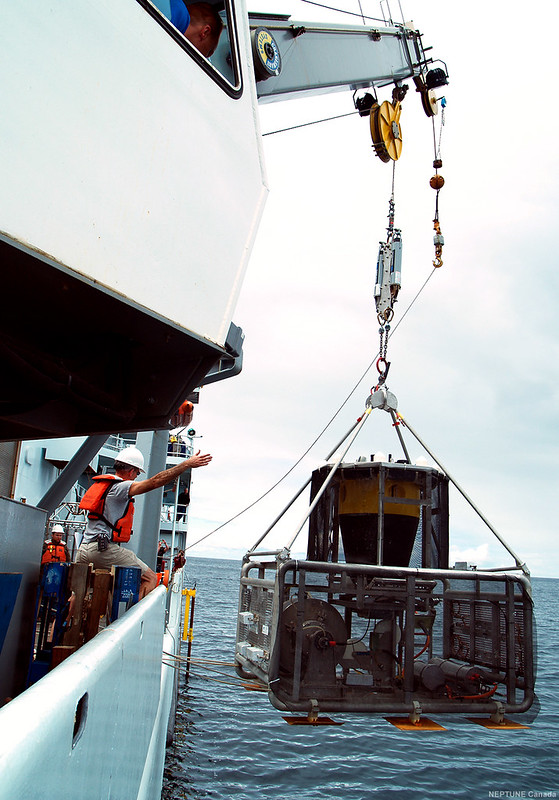May 31st @ 8:45pm – We had an event happen tonight that I think really illustrates the passion that great scientists bring to their field. On this last dive, ROPOS collected four shallow core samples, all of which were taken near, or in one case, in what appeared to be a gas hydrate formation. Gas hydrates are a unique, solid mixture of water and volatile gases, such as methane, that only remain solid at the right mixture of temperature and pressure, such as those on the continental slope near the Barkley node. Once destabilized by bringing them up to surface pressure and temperature, gas hydrates sublimate, turning directly into a gas.
If you look at the cumulative total of the academic credentials held by the scientists and engineers on board, it speaks to the high caliber of expertise supporting some very unique and interesting underwater experiments… hold that thought.
When the core samples were opened, the grey mud began to bubble and crackle, much like a bowl of Rice Krispies, and the foul smell of hydrogen sulphide (H2S) was unmistakably thick in the air. The first response from this group of professionals can only be described as giddy excitement. There was much pointing, rapid commentary, and smiles all around. I always remind my students that everyone needs to be passionate about something, and it is OK to get geeked out about that something, so I was honoured to be in room with others who share my curiosity and excitement over a small pile of stinky, grey mud.
Blog post and photos by Scott Doehler
Marine Educator
Daily blogs written by Scott, a biology and geography teacher, and Goksenin, a PhD student at UVic, as part of Ocean Networks Canada's Ship 2 Shore Marine Educators program.
Thursday 31 May 2012
Wally II Returns
May 31st @ 7:15pm – After an impressively long dive (over 13 hours), ROPOS completed one of its main objectives: deploying Wally 1 and bringing Wally II back to the surface from almost 1000 m depth. There is a lot of activity on deck when equipment arrives back on the surface, and this was no exception. One of the unique characteristics of ROPOS, other than its incredible manouverability and dexterity working underwater, is its tremendous lift capability, bringing heavy equipment down to the seafloor and bringing other gear back up to surface again.
As ROPOS broke the surface, we all anxiously watched as Wally II, in its basket emerged, dangling underneath.
After a series of crane hoists and a good towel down, Wally II has now been safely tucked away in the main lab after a flawless year exploring the depths.
Blog post and photos by Scott Doehler
Marine Educator
After a series of crane hoists and a good towel down, Wally II has now been safely tucked away in the main lab after a flawless year exploring the depths.
Blog post and photos by Scott Doehler
Marine Educator
Wally I Takes the Plunge
May 31st @ 8:30 am – Houston… Wally has landed. On a research ship like this, where the focus is primarily on the seafloor, it doesn’t matter whether it is night or day, the activities run 24 hours a day. ROPOS, with Wally strapped to its underside, began its descent early this morning, around 2 am, and reached the gas hydrate fields along at Barkley a few moments ago.
Where I usually sit in the main lab, Wally was only a metre away, so although parting is such sweet sorrow, I can’t wait to see him in action on the seafloor, especially since the drivers will be sitting in Bremen, Germany and operating Wally through the Internet. He’ll be down there ‘sniffing’ around the gas hydrates, surveying the seafloor and managing experiments for about a year, before once again coming up for cleaning and servicing, when his twin (who we will pull off the bottom in few hours) takes his place.
Wally used to have a bumper sticker on him that read: “How’s My Driving? Call…” and there was a phone number in Germany. But on the last deployment, Wally accidently disengaged from the underside of ROPOS at the surface, and plummeted all the way down to the sea floor (rather than the slow, controlled descent that is the norm). And though he survived the plunge unscathed, he now has a new message on his backside: “Fragile! Do Not Drop” (see photo below, top right).
Blog post and photos by Scott Doehler
Marine Educator
Where I usually sit in the main lab, Wally was only a metre away, so although parting is such sweet sorrow, I can’t wait to see him in action on the seafloor, especially since the drivers will be sitting in Bremen, Germany and operating Wally through the Internet. He’ll be down there ‘sniffing’ around the gas hydrates, surveying the seafloor and managing experiments for about a year, before once again coming up for cleaning and servicing, when his twin (who we will pull off the bottom in few hours) takes his place.
Wally used to have a bumper sticker on him that read: “How’s My Driving? Call…” and there was a phone number in Germany. But on the last deployment, Wally accidently disengaged from the underside of ROPOS at the surface, and plummeted all the way down to the sea floor (rather than the slow, controlled descent that is the norm). And though he survived the plunge unscathed, he now has a new message on his backside: “Fragile! Do Not Drop” (see photo below, top right).
Blog post and photos by Scott Doehler
Marine Educator
Wednesday 30 May 2012
A Change in the Weather
May 30th @ 9:05 am – One of the kitchen staff remarked to me at breakfast this morning that “…now we’ve got normal open ocean weather, and it doesn’t feel like we’re just out on a lake somewhere”. The wind has picked up, the clouds make the horizon appear as a fuzzy line, and the sea swell and whitecap waves buffet the ship. As I wander out on deck to watch the water churn and roil, I have to mind where I walk lest I get a free shower from water cascading off the edge of one of the upper decks.
It has certainly changed from the idyllic flat calm and sunshine of a little over a day ago. Another great quote I heard from one of the science party, whose quarters were near the front of the ship, was that the sound of the bow thrusters constantly firing to keep the ship on station and pointing in the right direction was “…like a washing machine full of hammers”.
Photographs don’t really do justice to the way the ship gets tossed around in the open ocean, so perhaps the best way to illustrate the pitch of the ship is by watching the level of juice in the juice fountain in the cafeteria, a more familiar reference.
But, for all the changes on the surface of the ocean, down in the depths, where ROPOS is right now, it’s business as usual, as the seafloor conditions don’t change very much.
Blog post and photos by Scott Doehler
Marine Educator, Ocean Networks Canada
It has certainly changed from the idyllic flat calm and sunshine of a little over a day ago. Another great quote I heard from one of the science party, whose quarters were near the front of the ship, was that the sound of the bow thrusters constantly firing to keep the ship on station and pointing in the right direction was “…like a washing machine full of hammers”.
Photographs don’t really do justice to the way the ship gets tossed around in the open ocean, so perhaps the best way to illustrate the pitch of the ship is by watching the level of juice in the juice fountain in the cafeteria, a more familiar reference.
But, for all the changes on the surface of the ocean, down in the depths, where ROPOS is right now, it’s business as usual, as the seafloor conditions don’t change very much.
Blog post and photos by Scott Doehler
Marine Educator, Ocean Networks Canada
Tuesday 29 May 2012
Help with Your Sea Legs
May 29th @ 2:20pm - When working for days, or weeks on end aboard a research ship such as the Thompson, one of the things that isn’t discussed much, but everyone is concerned about, is motion sickness. With the great amount money and time spent on an important expedition of this nature, establishing your ‘sea legs’ is absolutely necessary to be able to carry out your component of the mission.
There are the lucky few who can handle a pitching and rolling ship with little ill effect, but for the rest, chemically numbing out the nerve cells in your ears (the semicircular canals) that register movement is required. I went to bed last night with no ill effects and definitely thought I was one of the lucky few, but awoke this morning to dizziness and nausea. Like the resonance of an earthquake bringing a tall building down, the motion of the ship was of just the right form to lay me flat it seems. Without question, a horrible feeling to have, but as a scientist, I embraced the opportunity to experiment on myself and see which of many remedies will work the best: Gravol, transdermal patches, or ginger. I started with the ‘patch’.
So, it is a testament to their dedication to marine research, that many of the people aboard this cruise work with their mild to severe susceptibility to seasickness and press on to gather the data that will allow us to better understand our oceans.
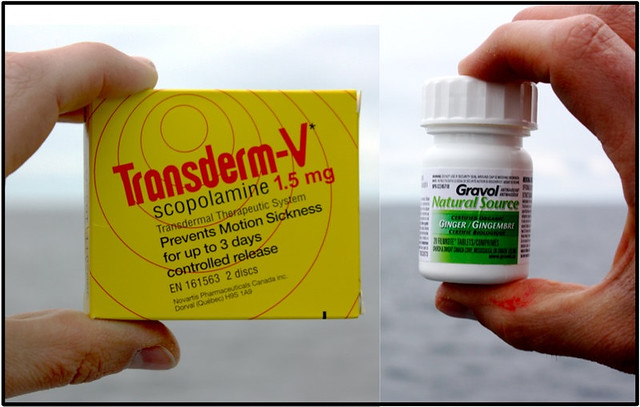
Blog post by Scott Doehler
Marine Educator, Ocean Networks Canada
There are the lucky few who can handle a pitching and rolling ship with little ill effect, but for the rest, chemically numbing out the nerve cells in your ears (the semicircular canals) that register movement is required. I went to bed last night with no ill effects and definitely thought I was one of the lucky few, but awoke this morning to dizziness and nausea. Like the resonance of an earthquake bringing a tall building down, the motion of the ship was of just the right form to lay me flat it seems. Without question, a horrible feeling to have, but as a scientist, I embraced the opportunity to experiment on myself and see which of many remedies will work the best: Gravol, transdermal patches, or ginger. I started with the ‘patch’.
So, it is a testament to their dedication to marine research, that many of the people aboard this cruise work with their mild to severe susceptibility to seasickness and press on to gather the data that will allow us to better understand our oceans.

Blog post by Scott Doehler
Marine Educator, Ocean Networks Canada
Photographing Sea Life
May 29th @ 12:10am - Yes, it’s just past midnight and ROPOS has been underwater for more than 2 hours now working on uncoiling cables and connecting power and data lines from instruments to junctions to the primary node at Barkley.
I had a chance tonight to work at the photographic station as a data logger. My job was to watch the HD video feed and instruct the DSC (Digital Still Camera) to snap a photo whenever anything interesting floated, swam, or crawled by (for my biology classes, that would be: ‘plankton’, ‘nekton’, and ‘benthos’ respectively). The photo is automatically logged as soon as the picture is taken (tagging it with time, location, and depth) and I had to add in a brief explanation of what was in the picture. Last night the majority of my comments were simply “Shark”, as we saw a large number of them.
What is really amazing, deep down in the ocean, is the sheer volume of particulate matter and plankton in the water column. As the pilots maneuvered ROPOS along its course, it was as if we were flying through a blizzard. And within this marine snowstorm, the photo logger’s job was to quickly identify the macroscopic marine life from the ‘snow’ and grab a picture before the object of interest drifted or swam out of view.
Blog post and photo by Scott Doehler
Marine Educator
I had a chance tonight to work at the photographic station as a data logger. My job was to watch the HD video feed and instruct the DSC (Digital Still Camera) to snap a photo whenever anything interesting floated, swam, or crawled by (for my biology classes, that would be: ‘plankton’, ‘nekton’, and ‘benthos’ respectively). The photo is automatically logged as soon as the picture is taken (tagging it with time, location, and depth) and I had to add in a brief explanation of what was in the picture. Last night the majority of my comments were simply “Shark”, as we saw a large number of them.
What is really amazing, deep down in the ocean, is the sheer volume of particulate matter and plankton in the water column. As the pilots maneuvered ROPOS along its course, it was as if we were flying through a blizzard. And within this marine snowstorm, the photo logger’s job was to quickly identify the macroscopic marine life from the ‘snow’ and grab a picture before the object of interest drifted or swam out of view.
Blog post and photo by Scott Doehler
Marine Educator
Monday 28 May 2012
Thoughts on an Endless Ocean
May 28th @ 4:15pm - I'm writing this sitting on the upper foredeck, in the bright sunshine, as the ship pitches up and down and side to side in the gentle, but nonetheless immense ocean swells that roll on beneath the ship. Our oceans are HUGE (an oft-cited, but poor excuse for willfully abusing them), and in looking out from my nearly 270 degree viewpoint near the front of the ship, you really get a sense of just how HUGE. No matter in which direction I look to the limits of the horizon, I cannot see land. And we're still only a day out, hovering over the relatively narrow continental shelf and slope... we have yet to venture out to the abyssal plain...
Blog post by Scott Doehler
Marine Educator
Marine Educator
Ogopogo Sighted!
May 28th @ 3:10pm - I just watched the deployment of the VPS instrument (Vertical Profiler System), nicknamed 'Ogopogo' off the starboard side of the ship. About the size of a small shed, this system consists of an anchored base unit with a tethered, instrumented float that can be deployed from the bottom of the seafloor. As the float rises vertically in the water column, much like a hot air balloon would in the atmosphere, it can measure a variety of characteristics of the ocean water through which it passes (temperature, conductivity, photosynthetic capacity, dissolved oxygen, etc.).
Once it completes a detailed bottom to surface run in this manner, the base unit can reel it back down, where it will wait until the next desired water column profile is needed. I'm imagining the engineering challenges of designing a system like this that is robust and reliable enough to operate for a long period of time in a host of changing ocean conditions.
Blog post by Scott Doehler
Marine Educator
Once it completes a detailed bottom to surface run in this manner, the base unit can reel it back down, where it will wait until the next desired water column profile is needed. I'm imagining the engineering challenges of designing a system like this that is robust and reliable enough to operate for a long period of time in a host of changing ocean conditions.
Blog post by Scott Doehler
Marine Educator
Where the Action Is...
May 28th @ 9:30am - When ROPOS is in the water, the spot to be is in the control room, a dark place lit by the glow of a multitude of television screens and monitors. In the front row, closest to the large displays, is where the pilots sit (I incorrectly called them 'drivers' and was swiftly corrected), who control all the functions of the ROV with a series of joysticks that would make any video game geek jealous.
Behind the pilots sit the 'loggers', whose job it is to record any and all events (technical, oceanographic, and biological) that take place during the dive. In the back of the room you can usually find an audience of scientists and crew who have a few minutes to stop to watch the exploration unfold.
It reminds me of mission control during a rocket launch, which I suppose is an apt comparison, as the environment we're exploring is, in many ways, as alien and technically challenging as exploring the lunar surface. I think that is what makes it so exciting!
Blog post and photo by Scott Doehler
Marine Educator
Behind the pilots sit the 'loggers', whose job it is to record any and all events (technical, oceanographic, and biological) that take place during the dive. In the back of the room you can usually find an audience of scientists and crew who have a few minutes to stop to watch the exploration unfold.
It reminds me of mission control during a rocket launch, which I suppose is an apt comparison, as the environment we're exploring is, in many ways, as alien and technically challenging as exploring the lunar surface. I think that is what makes it so exciting!
Blog post and photo by Scott Doehler
Marine Educator
ROPOS Launches at Barkley
May 28th @ 8:35am - Bright and early this morning I was able to find a great viewpoint on the aft deck from which to watch the launch of ROPOS (Remotely Operated Platform for Ocean Science). A giant, purpose-built crane lifted the SUV-sized ROV off the deck and over the side of the ship into the sea without much ceremony. ROPOS hovered at the surface for a minute before blowing its jets in a spray of frothing seawater and plunging down into the depths. After the deck crew deployed a string of 'lemons' (large, yellow, football-shaped floats to mark the position of the cable on the surface), the action moved from the brightness of the ship's deck to the contrastingly dark operations centre.
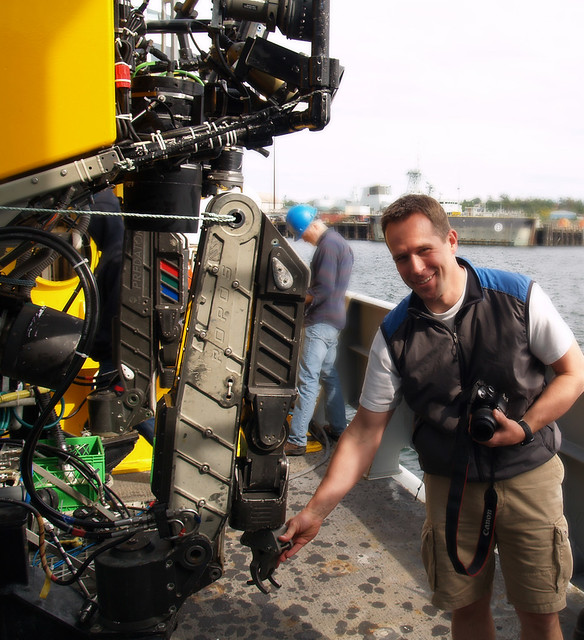
Blog post and photos (bottom series) by Scott Doehler
Marine Educator

Blog post and photos (bottom series) by Scott Doehler
Marine Educator
Sunday 27 May 2012
Full Steam Ahead
May 27th @ 10:20pm - While the ship makes a steady 20 knots towards our first objective - Barkley Canyon, I can certainly feel the change in the swell of the ocean that signifies we're leaving the relative safety of the Juan de Fuca Straight and entering the open Pacific.
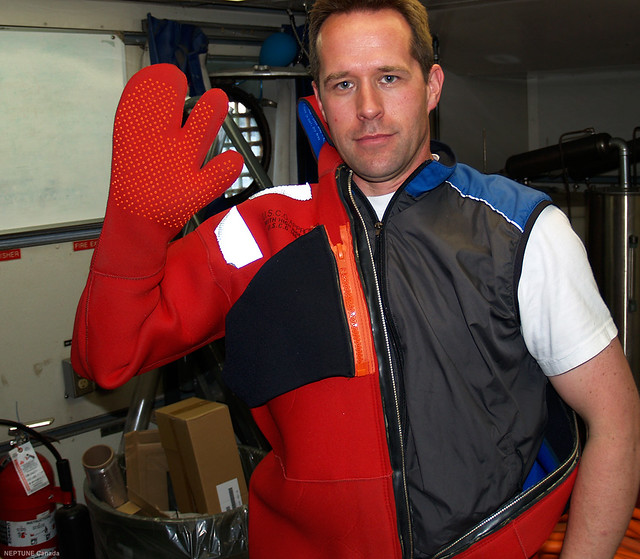 It's been a busy evening, in which at one point I found myself dressed in a full survival/exposure suit and feeling rather like a giant orange Gumby. Everyone has been gathering in their respective teams (communications, data loggers, instrumentation, etc.) to make sure we're all ready to hit the seafloor running when we arrive at Barkley in about seven hours (05:30 tomorrow morning).
It's been a busy evening, in which at one point I found myself dressed in a full survival/exposure suit and feeling rather like a giant orange Gumby. Everyone has been gathering in their respective teams (communications, data loggers, instrumentation, etc.) to make sure we're all ready to hit the seafloor running when we arrive at Barkley in about seven hours (05:30 tomorrow morning).

A highlight for me today was finding 'Wally' (the Internet-connected remotely operated bottom crawler) sitting quietly and inertly in a corner of the main science lab. What really geeks me out is shaking hands... or more accurately... shaking 'treads' with something that will be spending the next six months exploring the bottom of the ocean.
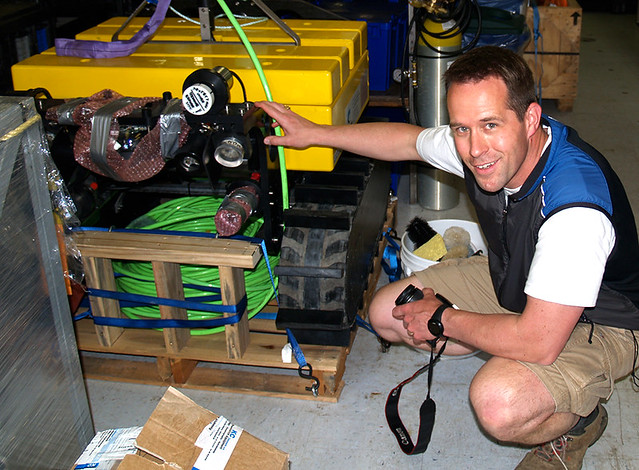 Blog post by Scott Doehler,
Blog post by Scott Doehler,
Marine Educator
 It's been a busy evening, in which at one point I found myself dressed in a full survival/exposure suit and feeling rather like a giant orange Gumby. Everyone has been gathering in their respective teams (communications, data loggers, instrumentation, etc.) to make sure we're all ready to hit the seafloor running when we arrive at Barkley in about seven hours (05:30 tomorrow morning).
It's been a busy evening, in which at one point I found myself dressed in a full survival/exposure suit and feeling rather like a giant orange Gumby. Everyone has been gathering in their respective teams (communications, data loggers, instrumentation, etc.) to make sure we're all ready to hit the seafloor running when we arrive at Barkley in about seven hours (05:30 tomorrow morning).
A highlight for me today was finding 'Wally' (the Internet-connected remotely operated bottom crawler) sitting quietly and inertly in a corner of the main science lab. What really geeks me out is shaking hands... or more accurately... shaking 'treads' with something that will be spending the next six months exploring the bottom of the ocean.
 Blog post by Scott Doehler,
Blog post by Scott Doehler,Marine Educator
Final Preparations Before Departure
May 27th @ 5:35pm - One of my students asked me what kind of restaurants would be on the ship, to which I replied that it really isn't that kind of ship! This is a working vessel, and my first impressions certainly confirm that statement in spades. After saying my goodbyes to my wife and three children, I walked past one of Canada's (in)famous submarines in dry dock, and boarded the Thomas G. Thompson, my home for the next 15 days.
The ship is a frenzied hive of activity, with people moving rapidly through the narrow passageways and labs, and across the open decks, while equipment is being loaded, stowed, installed, unpacked, hooked-up, tested, etc. I have met new people constantly and hope I can remember everyone's name. After "Hi" and the usual exchange of names, the next questions is inevitably: "What is your role on this mission?" It looks like a fascinating group of scientists and engineers, and I am looking forward to spending some time with the many folks I've only had 5 minutes to get to know so far, and explore further their connection with this voyage of discovery.
One thing I noticed right off the hop, is that just about every desk, deck, and working surface on the ship has anchor bolts strategically placed so that everything from computer monitors to huge equipment containers can be tied, strapped, or bungied down. If this is an indication of what is to come, perhaps I should be taking that Gravol or ginger root right now!
We are due to leave port soon, and the various rumblings in the bowels of the ship, and an announcement over the P.A. system that the gangplank is about to be pulled up, would indicate that she's getting ready!
Blog post by Scott Doehler
Marine Educator
The ship is a frenzied hive of activity, with people moving rapidly through the narrow passageways and labs, and across the open decks, while equipment is being loaded, stowed, installed, unpacked, hooked-up, tested, etc. I have met new people constantly and hope I can remember everyone's name. After "Hi" and the usual exchange of names, the next questions is inevitably: "What is your role on this mission?" It looks like a fascinating group of scientists and engineers, and I am looking forward to spending some time with the many folks I've only had 5 minutes to get to know so far, and explore further their connection with this voyage of discovery.
One thing I noticed right off the hop, is that just about every desk, deck, and working surface on the ship has anchor bolts strategically placed so that everything from computer monitors to huge equipment containers can be tied, strapped, or bungied down. If this is an indication of what is to come, perhaps I should be taking that Gravol or ginger root right now!
We are due to leave port soon, and the various rumblings in the bowels of the ship, and an announcement over the P.A. system that the gangplank is about to be pulled up, would indicate that she's getting ready!
Blog post by Scott Doehler
Marine Educator
Thursday 10 May 2012
Welcome Scott!
We're happy to welcome science teacher Scott Doehler as our on-ship educator for Wiring the Abyss 2012.
Born and raised in Scarborough, Ontario, the son of two teachers, Scott has, along with many fellow Canadians, opposed Earth’s rotation and slowly drifted west. After backpacking around the world for a year following University, he enjoyed 10 great years teaching junior high school in Edmonton and Calgary before shifting to ‘Island time’ and joining the Brentwood Faculty in 2008. He brings to Brentwood an absolute passion for the rocks, raw power and beauty of the biogeosphere. Scott teaches courses in Geology, Biology, and Introductory Engineering, and leads an annual trip for the entire Grade 10 class to the Bamfield Marine Science Centre.
Outside of the wonderful whirlwind that is Brentwood, Scott joins his wife Marianne – a fellow geologist - in passions for vocal music, snowboarding, and backcountry hiking. Summiting Kilimanjaro in Africa, and taking their 8-month-old son on his first month-long camping trip throughout Alaska and the Yukon exemplify the travel ‘bug’ that has so thoroughly bitten them both. Scott and Marianne live in beautiful Maple Bay with three wonderful children, two dogs, two cats, and one feisty horse.
Subscribe to:
Posts (Atom)








